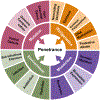Incomplete penetrance in primary immunodeficiency: a skeleton in the closet
- PMID: 32067110
- PMCID: PMC7275875
- DOI: 10.1007/s00439-020-02131-9
Incomplete penetrance in primary immunodeficiency: a skeleton in the closet
Abstract
Primary immunodeficiencies (PIDs) comprise a diverse group of over 400 genetic disorders that result in clinically apparent immune dysfunction. Although PIDs are classically considered as Mendelian disorders with complete penetrance, we now understand that absent or partial clinical disease is often noted in individuals harboring disease-causing genotypes. Despite the frequency of incomplete penetrance in PID, no conceptual framework exists to categorize and explain these occurrences. Here, by reviewing decades of reports on incomplete penetrance in PID we identify four recurrent themes of incomplete penetrance, namely genotype quality, (epi)genetic modification, environmental influence, and mosaicism. For each of these principles, we review what is known, underscore what remains unknown, and propose future experimental approaches to fill the gaps in our understanding. Although the content herein relates specifically to inborn errors of immunity, the concepts are generalizable across genetic diseases.
Keywords: Human genetics; Mosaicism; Penetrance; Primary immunodeficiency; Variable expressivity.
Conflict of interest statement
Conflict of Interest Statement
On behalf of all authors, the corresponding author states that there is no conflict of interest.
Figures
References
-
- Aldrich RA, Steinberg AG and Campbell DC (1954) ‘Pedigree demonstrating a sex-linked recessive condition characterized by draining ears, eczematoid dermatitis and bloody diarrhea.’, Pediatrics, 13(2), pp. 133–9. Available at: http://www.ncbi.nlm.nih.gov/pubmed/13133561. - PubMed
-
- Ameratunga R et al. (2017) ‘Epistatic interactions between mutations of TACI (TNFRSF13B) and TCF3 result in a severe primary immunodeficiency disorder and systemic lupus erythematosus’, Clinical & Translational Immunology. Nature Publishing Group, 6(10), p. e159. doi: 10.1038/cti.2017.41. - DOI - PMC - PubMed
Publication types
MeSH terms
Grants and funding
LinkOut - more resources
Full Text Sources


